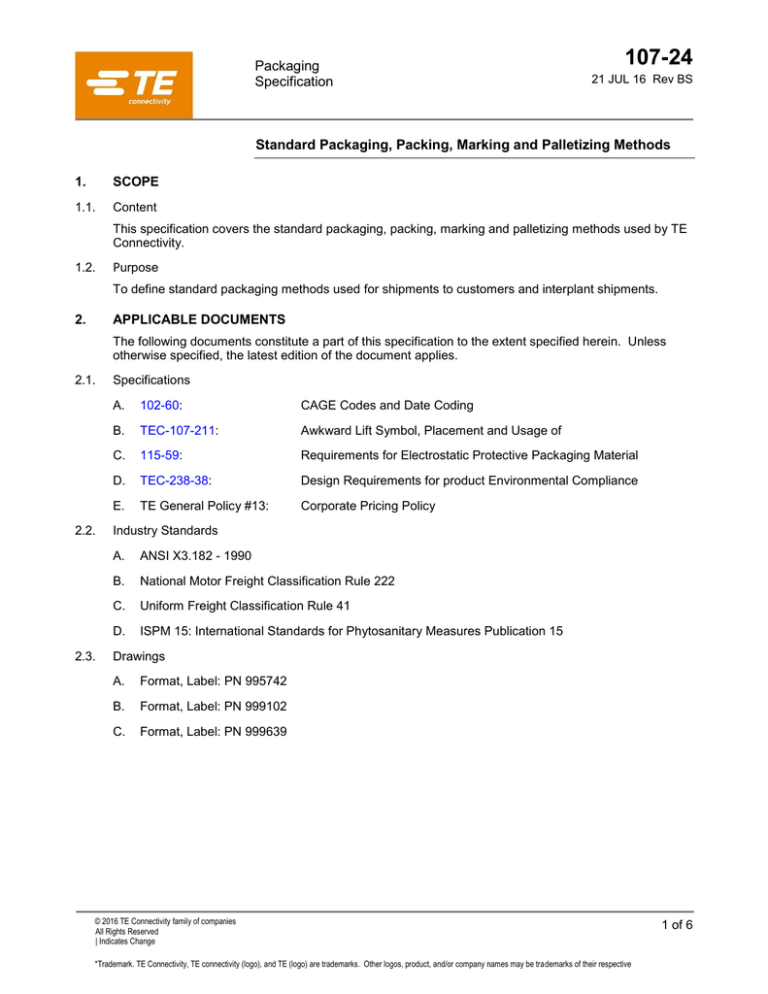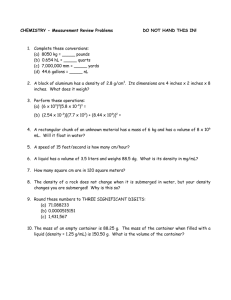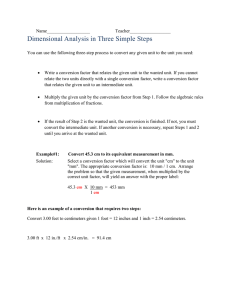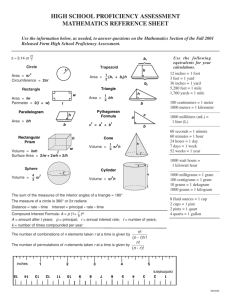
Packaging
Specification
107-24
21 JUL 16 Rev BS
Standard Packaging, Packing, Marking and Palletizing Methods
1.
SCOPE
1.1.
Content
This specification covers the standard packaging, packing, marking and palletizing methods used by TE
Connectivity.
1.2.
Purpose
To define standard packaging methods used for shipments to customers and interplant shipments.
2.
APPLICABLE DOCUMENTS
The following documents constitute a part of this specification to the extent specified herein. Unless
otherwise specified, the latest edition of the document applies.
2.1.
2.2.
2.3.
Specifications
A.
102-60:
CAGE Codes and Date Coding
B.
TEC-107-211:
Awkward Lift Symbol, Placement and Usage of
C.
115-59:
Requirements for Electrostatic Protective Packaging Material
D.
TEC-238-38:
Design Requirements for product Environmental Compliance
E.
TE General Policy #13:
Corporate Pricing Policy
Industry Standards
A.
ANSI X3.182 - 1990
B.
National Motor Freight Classification Rule 222
C.
Uniform Freight Classification Rule 41
D.
ISPM 15: International Standards for Phytosanitary Measures Publication 15
Drawings
A.
Format, Label: PN 995742
B.
Format, Label: PN 999102
C.
Format, Label: PN 999639
© 2016 TE Connectivity family of companies
All Rights Reserved
| Indicates Change
*Trademark. TE Connectivity, TE connectivity (logo), and TE (logo) are trademarks. Other logos, product, and/or company names may be trademarks of their respective
owners.
1 of 6
107-24
3.
PACKAGING
3.1.
All product shall be adequately packaged for physical protection.
3.2.
When determined by TE, protective materials such as desiccant and VPI brand paper or equivalent shall
be placed inside containers to prevent damage from atmospheric conditions.
3.3.
All ESD sensitive products shall be packaged in shielded containers as defined in Engineering
Specification 115-59.
3.4.
Where required, all packaging materials will be non-static generating.
3.5.
Parts shipped on separate purchase orders shall be in separate containers.
4.
PACKING
4.1.
When required, unit packages shall be packed in boxes that comply with Uniform Freight Classification
Rule 41 and National Motor Freight Classification Rule 222.
4.2.
Box closure shall conform to Uniform Freight Classification Rule 41 and National Motor Freight
Classification Rule 222.
4.3.
Depending upon type of product, gross weight of corrugated fibreboard shipping boxes shall be as
follows:
4.4.
A.
Manually handled reeled strip product: 20 Kilograms (45 pounds) max
B.
All other manually handled product: 16 Kilograms (35 pounds) max
Shipping boxes that meet either of the following criteria shall be marked with the awkward lift symbol PN
15905- (graphic Component) or PN 999208- (label).
□
□
A.
Exceed a weight of 16 Kilograms (35 pounds) or a lower weight threshold if local requirements
dictate, or
B.
Have two or more dimensions which individually equal or exceed 50 centimeters (20 inches).
NOTE
For proper placement and usage of this symbol, see Packaging Specification TEC-107-211.
4.5.
Empty cartons used as dunnage shall be marked "EMPTY".
4.6.
Sawdust, peanuts excelsior, shredded paper and other free flow materials shall not be used as
dunnage. Unless proven through transit testing to provide inadequate void fill, bubble pack/kraft paper
shall be the dunnage of choice for partial box quantities.
4.7.
Polyethylene bags shall be closed by heat sealing, wire tie or taping. DO NOT CLOSE BY STAPLING.
4.8.
Staples and glue are acceptable only as a joint stitch and may not be used for box closure on either top
or bottom. An exception may be granted for machine/application tooling upon the receipt of specific
written approval of the manufacturing organization’s executive management.
4.9.
If 2 or more part numbers are combined into 1 shipping container, the different part numbers must be
packaged in separate unit packages.
NOTE
This is applicable to only external customers. For intercompany shipments , there must be 1
shipping container per part number.
Rev BS
2 of 6
107-24
4.10. When product is bulk packed at the shipper level (400), customer special unit labeling is not required.
4.11. Shipper boxes shall be filled to capacity. Voids shall be filled with dunnage or empty boxes.
5.
MARKING
Restrictions on the use of Certain Hazardous Substances (RoHS) and End of Life Vehicles (ELV)
verbiage as required by Product Environmental Compliance Specification TEC-238-38.
NOTE
In order to address this requirement, as of March 31, 2005, all RoHS or ELV compliant products
shall be labeled in accordance with Product Environmental Compliance Specification TEC-23838. For your convenience, the following website will explain how to acquire appropriate Lead
Free initiative labels in the event you cannot print the lead free initiative verbiage directly on
your Label.
http://www.tycoelectronics.com/environment/leadfree/pdf/lead_free_labels.pdf
5.1.
Shipments to Customers
A.
B.
When feasible, each unit or intermediate container shall be marked with the following information:
1.
TE Part Number
2.
Quantity (when quantity of 1 is obvious, marking of quantity is optional)
3.
Date Code (when not shown on part)
4.
Approval information (when required)
5.
Country of Origin
Each shipping container shall be marked on 1 panel or 1 side as follows:
NOTE
When shipping Unit pallet loads, each container does not require a Ship to Label.
1.
TE Part Number
2.
TE Part Number Revision
3.
Customer Part Number (when shown on purchase order and shipping papers)
4.
Customer Revision Number (when shown on purchase order and shipping papers)
5.
Subcontractor Part Number (when shown on purchase order and shipping papers)
6.
Customer Purchase Order Number (Customer Purchase Order Number required if standard
Ship to Label is applied.
7.
Quantity
8.
Date Code, see Para 5.5.
9.
Appropriate UL & CSA approval marking (when applicable)
10. All shipping containers shall be designated 1 of __, 2 of __, etc.
11. When containers of product imported from foreign countries are broken down, the new
container shall be marked with the name of the country from which the product was imported.
12. Country of origin name in English
13. Hazardous Material Marking, as required by EU, DOT, IATA and ICAO regulations, if applicable
Rev BS
3 of 6
107-24
14. Trace Number
The first 5 digits indicate the source of the product: 2-digit country code + building number. The
next set of numbers (up to 10) is flexible to meet varied trace and business unit requirements.
U
S
1
8
1
Country US, MX or
other + Building
4
4
0
0
1
2
8
B
The business unit determines a format that will assure the
appropriate level of traceability. For example; it could be (team
or work center) + (date code) + (shift).
NOTE
The Secondary Trace Number field may be used for Primary Trace Number character overflow
or for additional or alternate characters (e.g. plating batch trace) as required or applicable.
15. Appropriate RoHS/ELV verbiage in accordance with Product Environmental Compliance
Specification TEC-238-38.
5.2.
Interplant Shipments within TE
A.
Each unit, intermediate (when feasible) and shipping container (mandatory) must have a Product
Identification label attached consisting of the following information (as a minimum):
1.
TE Part Number
2.
TE Part Number Revision
3.
TE Purchase Order Number/ Factory Order Number
4.
Quantity
5.
Country of Origin in English
6.
Trace Number (Same format as shown in Para 5.1.B.14.
7.
Date Code (Date of manufacture)
8.
Appropriate Approval Markings, such as UL, UR and CSA, if applicable
9.
TE Raw Material Part Number when UL, UR and CSA logos are used, if applicable
10. Hazardous Material Marking, as required by EU, DOT, IATA and ICAO regulations, if applicable
11. Visible Indication of Acceptability (inspector number/identifier) in the form of stamp, punch clock
number, initials or signature
12. Building Number of Manufacturing Location
5.3.
For each shipping container that is marked with a Global License Tag, one of the following standard
Label Formats shall be used. The bar code shall be code 39 symbology and the overall grade must be
equal to or better than a grade of “C” in accordance with ANSI X3 .182-1990 Bar Code Print Quality
guideline.
A.
SAP Global format:
PN 999639
B.
SAP Mini License Tag:
PN 995742
C.
APICS & Legacy Systems: PN 999102
NOTE
All License Tag data shall be electronically delivered to the receiving location via EDI ASN 856
transaction or equivalent.
Once a verification of a non-scannable Global License Tag is completed, results why it cannot be
scanned should be communicated back to the originator of the Global License Tag.
Rev BS
4 of 6
107-24
5.4.
Shipping containers that contain multiple part numbers (consolidation containers) shall be marked with
the following:
The statement "Applicable Product Information Included".
5.5.
Date code marking shall be in accordance with Quality Specification 102-60 and consist of the following:
A.
The manufacturing date should always be used as the date of reference when labeling product that
will be packaged in the manufacturing process. Primary or unit packages must contain product with
only one date code. Intermediate and shipper packaging may contain product with two date codes
from the same factory order and the outermost label should be marked with the oldest date code.
B.
When product is sent to the distribution centers in reusable containers (example: totes, racks or
bins) the product or containers must be labeled and the date coded as stated above. The labels
applied to any shipping container for this product should have the same date code as the product
being packaged. When mixed date code product is packaged in the same container, the oldest
date code should be used on the outer container.
C.
The date code shall be a four or five digit number. The first two digits shall indicate the year that
the part was manufactured. The next two digits shall indicate the manufacturing week. The fifth
digit, which is optional, shall indicate the day of the manufacturing week.
93
41
Year
Week
3
Day (optional)
Figure 1
5.6.
If 2 or more containers containing different part numbers are combined into 1 shipping container, those
smaller inside containers shall be marked per Para 5.1.
6.
PALLETIZING
6.1.
Ensure that each shipping container is marked in accordance with Para 5.2. prior to palletizing.
6.2.
When the total shipment of boxes occupies a space equal to or greater than 48 inches long by 40 inches
wide by 24 inches high, the shipment shall be palletized.
6.3.
General Palletization Parameters
NOTE
All pallets must conform to ISPM Publication 15.
A.
Rev BS
Standard pallets used shall be as follows:
1.
PN 18573-1 four way entry 1016 mm long by 1220 mm wide (40 inches long by 48 inches
wide)
2.
PN 995398-1 two way entry 1067 mm long by 1067 mm wide (42 inches long by 42 inches
wide)
3.
PN 995135-1 four way entry 1220 mm long by 1067 mm wide (48 inches long by 42 inches
wide)
4.
Where no shipping instructions specify usage of above standard pallets, shipping locations may
utilize pallets that do not exceed 1296 mm by 1220 mm long (51 inches long by 48 inches wide.
5 of 6
107-24
B.
Maximum height of load and pallet:
1.
173 centimeters (68 inches) - reeled product (Surface transportation only, does not apply to air
freight)
2.
112 centimeters (44 inches) - all other
3.
127 centimeters (50 inches) - all product, Automotive Division only (NCDC Only)
4.
160 centimeters (63 inches) - loose piece UPS, FedEx, export. 127 centimeters (50 inches) all
other (WCDC Only) (This applies to all freight including reeled product)
5.
122 centimeters (48 inches) - all product (EPDC Only)
6.
213 centimeters (84 inches) - all product, Energy Division only
7.
221 centimeters (87 inches) - all product (MPDC Only)
C.
Maximum weight of load on pallet: 907 kilograms (2000 pounds)
D.
Containers shall not overhang the edges of the pallet to the extent that product damage may occur.
E.
Based on local/specific business requirements, the top surface of the pallet load may be flat to
allow for double stacking. The flatness of the pallet load is the desired outcome but may not be
practical for all shipments. When necessary, use boxes marked “EMPTY” to make the top layer
flat. Empty boxes placed in the pallet interior shall have an “EMPTY” marking visible from the top
of the pallet load. Multiple empty boxes shall not be used continuously along any edge of pallet.
F.
Containers shall be secured to pallet using plastic or metal strapping or stretch wrap film. Edge
protectors shall be used under strapping to ensure banding will be severed/cut by sharp edges.
Two straps shall be applied lengthwise and two straps girthwise.
G.
1.
For loads greater than 350 kilograms (800 pounds), steel banding is preferred, however, heavy
duty polyester, polypropylene, or polyamide banding may be used if the tensile strength is
adequate for proper securement.
2.
Polyester, polypropylene or polyamide banding shall be used for all others.
Where feasible, boxes should be positioned on the pallet in such a manner that labels are visible.
7.
SPECIAL CHARGE APPLICATION
7.1.
Special packaging charges shall be assessed per TE General Policy #13 for specific customer
requirements such as:
A.
Special labeling and/or marking. (Unit package marking, etc.)
B.
Specific pallet sizes.
C.
Variance from standard package quantity.
8.
PACKING SLIP
8.1.
Packing slip shall be attached to the outside of the number 1 carton in all shipments unless prohibited by
carton size.
8.2.
If carton size is too small to attach packing slip, it shall be placed inside and the carton marked "Packing
Slip Enclosed".
Rev BS
6 of 6





